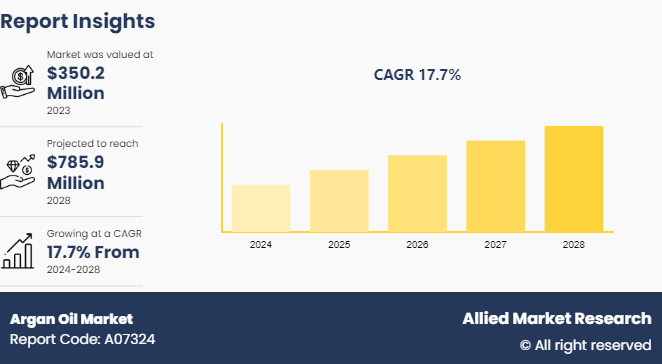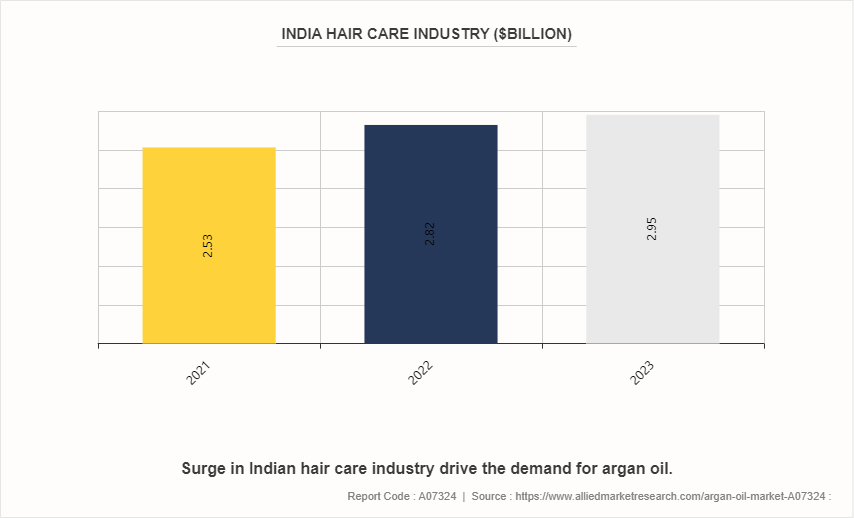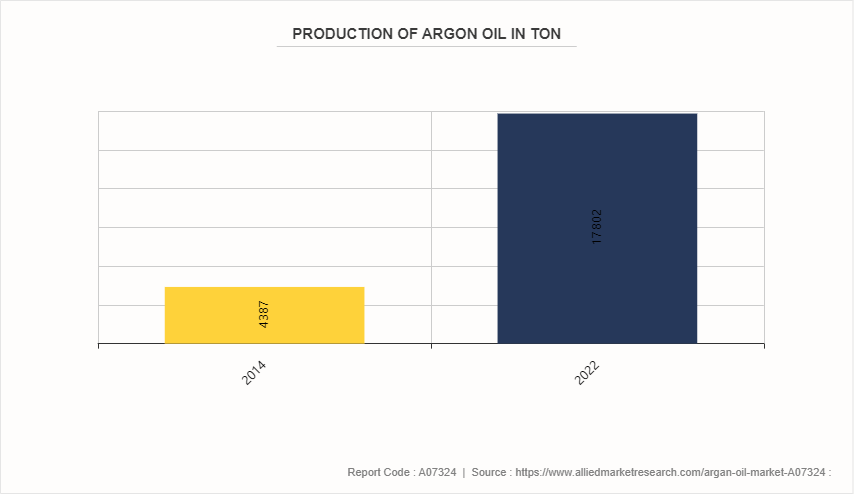Argan Oil Market Research, 2028
The global argan oil market size was valued at $350.2 million in 2023, and is projected to reach $785.9 million by 2028, growing at a CAGR of 17.7% from 2024 to 2028.

Market Introduction and Definition
Argan oil, often referred to as liquid gold, is a plant oil produced from the kernels of the argan tree which is endemic to Morocco. The production process of argan oil is labor-intensive and involves several steps to ensure the oil's quality and purity, whether by traditional or modern methods. Both methods emphasize sustainability, fair trade, and environmental protection, ensuring that the production of argan oil benefits local communities and ecosystems. Furthermore, argon oil has gained significant popularity in recent years for its numerous benefits and applications in cosmetics, culinary, and medicinal fields. Argon oil is rich composition of fatty acids, vitamin E, and antioxidants, which makes it beneficial for skin, hair, and overall health. Its applications range from cosmetic and culinary to medicinal uses.
Key Takeaways
- The argon oil market study covers 20 countries. The research includes a segment analysis of each country in terms of value for the projected period.
- More than 1, 500 product literatures, industry releases, annual reports, and other such documents of major asphalt participants along with authentic industry journals, trade associations' releases, and government websites have been reviewed for generating high-value industry insights.
- The study integrated high-quality data, professional opinions and analysis, and critical independent perspectives. The research approach is intended to provide a balanced view of global markets and to assist stakeholders in making educated decisions to achieve their most ambitious growth objectives.
Market Dynamics
The market for argan oil has been expanding rapidly due to consumer preferences, health benefits, and several other socio-economic factors. Consumers are becoming more conscious of the harmful effects of synthetic chemicals and are opting for products with natural ingredients. Argan oil is renowned for its moisturizing, anti-aging, and anti-inflammatory properties, making it a popular ingredient in skincare and haircare products. Moreover, argan oil is used in various cosmetic products, including moisturizers, serums, shampoos, conditioners, and makeup. Its versatility and effectiveness have led to widespread adoption by major cosmetic brands. Rise in awareness about the benefits of natural and organic products has driven the demand for argan oil, particularly in the beauty and personal care industry.

However, the growth of the argan oil market is restrained by factors such as limited supply due to geographical and environmental constraints, high production costs, and price sensitivity among consumers. Issues with authenticity and adulteration, along with regulatory challenges and the need for consumer education, also pose significant barriers. The traditional production process of argan oil is highly labor-intensive, involving manual harvesting, nut cracking, and oil extraction, which increases production costs. Furthermore, ensuring high quality and purity of the oil involves rigorous testing and filtration processes, further adding to costs. In addition, sustainability and ethical concerns, as well as market saturation, can impact the market expansion. Addressing these restraining factors is crucial for the sustained growth and development of the argan oil industry.
Ongoing research and development in cosmetics industry lead to the demand for high-quality argon oil. Creating multi-functional cosmetic products which combine the benefits of argan oil with other active ingredients can provide added value and convenience for consumers. Developing skincare products like anti-aging creams, moisturizers, serums, and body lotions which leverage the benefits of argan oil can attract consumers seeking natural and effective skincare solutions. Furthermore, exploring new applications of argan oil in pharmaceuticals, nutraceuticals, and therapeutic products are projected to open up additional revenue streams for the industry.
Market Segmentation
The argon oil market is segmented into grade, acidity level and application. By type, the market is divided into food grade, cosmetics grade and others. By acidity, the market is categorized into extra-virgin, fine-virgin, ordinary virgin and others. By application, the market is classified into personal care and cosmetics, medical, food and others. Region-wise, the market is analyzed across North America, Europe, Asia-Pacific, and LAMEA.
Regional Market Outlook
Major cities in China, India, and Southeast Asian nations are experiencing growth in cosmetic, pharma, and food industry. Rise in awareness about the benefits of argan oil, such as its moisturizing, anti-aging, and healing properties, is driving demand for argon oil in the region. Furthermore, rapid urbanization is changing lifestyles, leading to greater demand for beauty and wellness products among urban populations. Consumers are becoming more knowledgeable about natural and organic products which boost the demand for natural cosmetic products. China is one of the largest markets for beauty and personal care products. The demand for argan oil is experiencing growth as consumers seek high-quality, natural ingredients in the country. Moreover, the boost in the preference for Ayurvedic and natural products in India creates a favorable market for argan oil.
- The natural and organic cosmetics industry has witnessed a growing demand for products labeled as "natural, " "organic, " "sustainable, " or "green." These labels are now key drivers of consumer purchasing decisions in China’s cosmetics market.
- In 2023, China’s cosmetics sector reached $60.7 billion, making up 17.3% of the global market and positioning the country second only to the U.S., which holds 20%. Despite this, the China’s beauty market continues to experience rapid year-on-year growth.
- Notably, within the Asia-Pacific region, China is expected to account for nearly 70% of the growth in the regional beauty and personal care market through 2025.
Competitive Landscape
The major players operating in the argon oil market include Arganisme, Olvea, Zineglob, Saadia Organics., INDIA AROMA OILS AND COMPANY., Kamakhya, Organica Group, K. K. Enterprise., O&3 Limited and Kerfoot Group.
Production of Argon Oil, By Globally
Below mentioned graph depicts the global production of argon oil. In 2014, the production of argon oil was around 4, 387 tons which increased to 17,802 tons in 2022.

Industry Trends
- Rapid urbanization and increase in population in developing countries lead to rise in the demand for cosmetic products, driving the demand for argon oils.
- Significant spending of healthy food and oil products is boosting the use of argon oils? in the developing countries.
- One of the most notable achievements has been the rehabilitation of 164, 470 hectares of argan forest by 2020, representing 82% of the target set under the Green Morocco Plan.
- The planting of argan trees under the Argan Agriculture Program has covered an area of 2, 160 hectares, contributing to the regeneration of the argan forest.
- The new contract program for the argan sector, covering the period from 2021 to 2030, aims to rehabilitate an additional 411, 000 hectares of argan forest, plant 50, 000 hectares of argan orchards, and increase argan oil production to 10, 000 tons by 2030, with 50% of the production being exported in bottled form.
Major Plans of Argon Oil
- By financing 80% of the total investment cost, the Green Climate Fund (GCF) is scaling up Morocco’s argan orchards programme. GCF’s grant support has been crucial to de-risking this project.
- The Indian government said it plans to regenerate 200, 000 hectares of Argan forest, create a new chain of modern Argan farms.
Key Sources Referred
- Argancare Organisation
- Saadia Organics.
- Argane Aouzac
- Argan Farm
- Arcensels
- The Cosmetics Association, Ltd
- Cosmetics Europe
- American Cosmetic Manufacturers Association
- ASEAN Cosmetics Association, Inc.
Key Benefits For Stakeholders
- This report provides a quantitative analysis of the market segments, current trends, estimations, and dynamics of the argan oil market analysis from 2024 to 2028 to identify the prevailing argan oil market opportunities.
- The market research is offered along with information related to key drivers, restraints, and opportunities.
- Porter's five forces analysis highlights the potency of buyers and suppliers to enable stakeholders make profit-oriented business decisions and strengthen their supplier-buyer network.
- In-depth analysis of the argan oil market segmentation assists to determine the prevailing market opportunities.
- Major countries in each region are mapped according to their revenue contribution to the global market.
- Market player positioning facilitates benchmarking and provides a clear understanding of the present position of the market players.
- The report includes the analysis of the regional as well as global argan oil market trends, key players, market segments, application areas, and market growth strategies.
Argan Oil Market Report Highlights
| Aspects | Details |
| Market Size By 2028 | USD 785.9 Million |
| Growth Rate | CAGR of 17.7% |
| Forecast period | 2024 - 2028 |
| Report Pages | 350 |
| By Grade |
|
| By Acidity |
|
| By Application |
|
| By Region |
|
| Key Market Players | Saadia Organics., Organica Group, Arganisme, Kamakhya, K. K. Enterprise., INDIA AROMA OILS AND COMPANY., OLVEA, O&3 Limited, Kerfoot Group, Zineglob |
The global argan oil market was valued at $350.2 million in 2023, and is projected to reach $785.9 million by 2028, growing at a CAGR of 17.7% from 2024 to 2028.
Asia-Pacific is the largest regional market for Argan Oil.
Cosmetic is the leading application of Argan Oil Market
Development of personalized personal care products is the upcoming trends of Argan Oil Market in the globe.
The major players operating in the argon oil market include Arganisme, Olvea, Zineglob, Saadia Organics., INDIA AROMA OILS AND COMPANY., Kamakhya, Organica Group, K. K. Enterprise., O&3 Limited and Kerfoot Group.
Loading Table Of Content...



